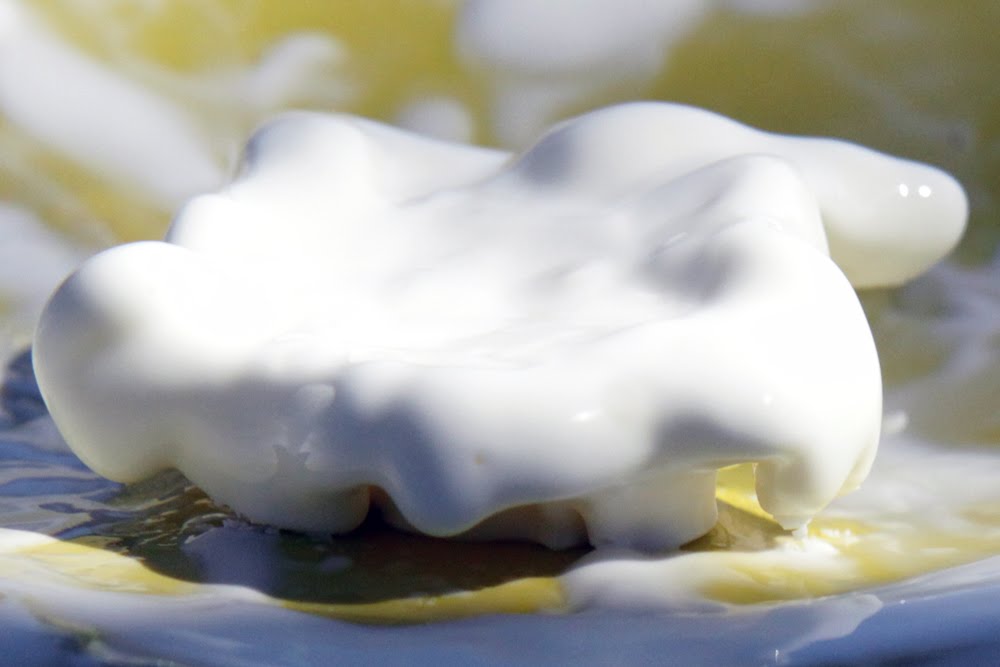Non-Newtonian Fluid
A non-Newtonian fluid is a fluid whose flow properties differ in any way from those of Newtonian fluids. Most commonly the viscosity (resistance to deformation or other forces) of non-Newtonian fluids are dependant on shear rate or shear rate history. However, there are some non-Newtonian fluids with shear-independent viscosity, that nonetheless exhibit normal stress-differences or other non-Newtonian behaviour.
Many salt solutions and molten polymers are non-Newtonian fluids, as are many commonly found substances such as ketchup, custard, toothpaste, starch suspensions, paint, blood, and shampoo. In a Newtonian fluid, the relation between the shear stress and the shear rate is linear, passing through the origin, the constant of proportionality being the coefficient of viscosity. In a non-Newtonian fluid, the relation between the shear stress and the shear rate is different, and can even be time-dependent. Therefore a constant coefficient of viscosity cannot be defined.
 Fluid You Can Walk On
Fluid You Can Walk On
A non-Newtonian fluid is a fluid whose viscosity is variable based on applied stress. The most commonly known non-Newtonian fluid is cornstarch dissolved in water. Contrast with Newtonian fluids like water, whose behavior can be described exclusively by temperature and pressure, not the forces acting on it from second to second. Non-Newtonian fluids are fascinating substances that can be used to help us understand physics in more detail, in an exciting, hands-on way.
Therefore, although the concept of viscosity is commonly used in fluid mechanics to characterize the shear properties of a fluid, it can be inadequate to describe non-Newtonian fluids. They are best studied through several other rheological properties which relate stress and strain rate tensors under many different flow conditions, such as oscillatory shear, or extensional flow which are measured using different devices or rheometers. The properties are better studied using tensor-valued constitutive equations, which are common in the field of continuum mechanics.
If you punch a bucket full of a shear thickening non-Newtonian fluid, the stress introduced by the incoming force causes the atoms in the fluid to rearrange such that it behaves like a solid. Your hand will not go through. If you shove your hand into the fluid slowly, however, it will penetrate successfully. If you pull your hand out abruptly, it will again behave like a solid, and you can literally pull a bucket of the fluid out of its container in this way.
A shear thinning non-Newtonian fluid behaves in the opposite way. In this type, the fluid becomes thinner, rather than thicker, when stress is applied. Also called pseudoplastic, examples of this type of non-Newtonian fluid include ketchup, toothpaste, and paint. The effect doesn’t usually last for long in either type, continuing only as long as the stress is applied.
A fluid that departs from the classic linear newtonian relation between stress and shear rate. In a strict sense, a fluid is any state of matter that is not a solid, and a solid is a state of matter that has a unique stress-free state. A conceptually simpler definition is that a fluid is capable of attaining the shape of its container and retaining that shape for all time in the absence of external forces. Therefore, fluids encompass a wide variety of states of matter including gases and liquids as well as many more esoteric states (for example, plasmas, liquid crystals, and foams).
You might also like
| Solar Storm 2012 Solar Storm Warning Scientists have been... | Transport Phenomena What is Transport Phenomena ? In engineering... | Smart Material : Ferrofluid What is Ferrofluid ? A ferrofluid (portmanteau... | Smart Materials What are Smart Materials ? Smart materials are... |


 Alloy Suppliers
Alloy Suppliers
 Aluminum
Aluminum
 Aluminum Extrusions
Aluminum Extrusions
 Copper-Brass-Bronze
Copper-Brass-Bronze
 Nickel
Nickel
 Magnets
Magnets
 Stainless Steel
Stainless Steel
 Stainless Steel Tubing
Stainless Steel Tubing
 Steel Service Centers
Steel Service Centers
 Titanium
Titanium
 Tungsten
Tungsten
 Wire Rope
Wire Rope